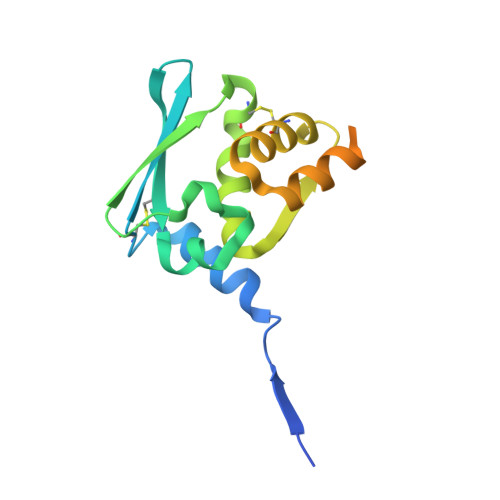The Antiviral Activity of the Cellular Glycoprotein LGALS3BP/90K Is Species Specific.
Lodermeyer, V., Ssebyatika, G., Passos, V., Ponnurangam, A., Malassa, A., Ewald, E., Sturzel, C.M., Kirchhoff, F., Rotger, M., Falk, C.S., Telenti, A., Krey, T., Goffinet, C.(2018) J Virol 92
- PubMed: 29743357
- DOI: https://doi.org/10.1128/JVI.00226-18
- Primary Citation of Related Structures:
6GFB, 6GFC - PubMed Abstract:
Cellular antiviral proteins interfere with distinct steps of replication cycles of viruses. The galectin 3 binding protein (LGALS3BP, also known as 90K) was previously shown to lower the infectivity of nascent human immunodeficiency virus type 1 (HIV-1) virions when expressed in virus-producing cells. This antiviral effect was accompanied by impaired gp160Env processing and reduced viral incorporation of mature Env glycoproteins. Here, we examined the ability of 90K orthologs from primate species to reduce the particle infectivity of distinct lentiviruses. We show that 90K's ability to diminish the infectivity of lentiviral particles is conserved within primate species, with the notable exception of 90K from rhesus macaque. Comparison of active and inactive 90K orthologs and variants uncovered the fact that inhibition of processing of the HIV-1 Env precursor and reduction of cell surface expression of HIV-1 Env gp120 are required, but not sufficient, for 90K-mediated antiviral activity. Rather, 90K-mediated reduction of virion-associated gp120 coincided with antiviral activity, suggesting that 90K impairs the incorporation of HIV-1 Env into budding virions. We show that a single "humanizing" amino acid exchange in the BTB (broad-complex, tramtrack, and bric-à-brac)/POZ (poxvirus and zinc finger) domain is sufficient to fully rescue the antiviral activity of a shortened version of rhesus macaque 90K, but not that of the full-length protein. Comparison of the X-ray structures of the BTB/POZ domains of 90K from rhesus macaques and humans point toward a slightly larger hydrophobic patch at the surface of the rhesus macaque BTB domain that may modulate a direct interaction with either a second 90K domain or a different protein. IMPORTANCE The cellular 90K protein has been shown to diminish the infectivity of nascent HIV-1 particles. When produced in 90K-expressing cells, particles bear smaller amounts of the HIV-1 Env glycoprotein, which is essential for attaching to and entering new target cells in the subsequent infection round. However, whether the antiviral function of 90K is conserved across primates is unknown. Here, we found that 90K orthologs from most primate species, but, surprisingly, not from rhesus macaques, inhibit HIV-1. The introduction of a single amino acid exchange into a short version of the rhesus macaque 90K protein, consisting of the two intermediate domains of 90K, resulted in full restoration of antiviral activity. Structural elucidation of the respective domain suggests that the absence of antiviral activity in the rhesus macaque factor may be linked to a subtle change in protein-protein interaction.
Organizational Affiliation:
Institute of Molecular Virology, Ulm University Medical Center, Ulm, Germany.

















